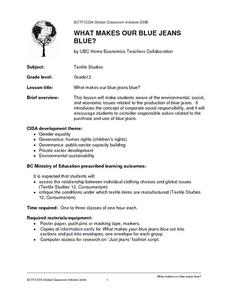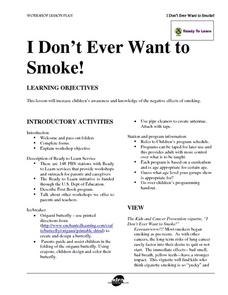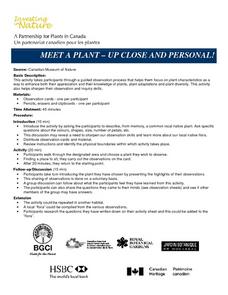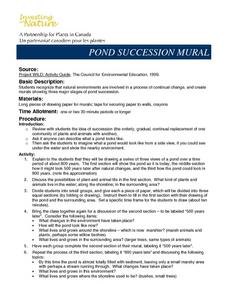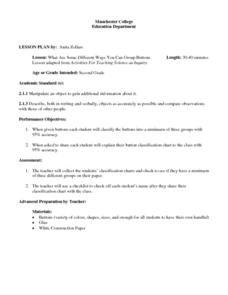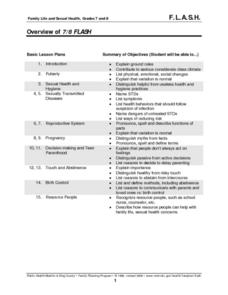Curated OER
WHAT MAKES OUR BLUE JEANS BLUE?
Twelfth graders become aware of the environmental, social and economic issues related to the production of blue jeans. They explore the relationship between individual clothing choices as well as global issues. In addition, they...
Curated OER
Determine the molarity of an unknown HCl solution
Students complete a lab to help develop a comprehension of stiochiometry. They review equation writing, equation balancing, and stiochiometry. Studnets are given the following information: Sloppy students from the previous class have...
Curated OER
Eutrophication Lab
Middle schoolers examine the effects of detergents and fertilizers on aquatic life and describe algae. Students define the term eutrophication as the process by which a body of water, such as a pond, lake, stream, or river, has a sudden...
Curated OER
Facilitators Workshop
Students experience leading and facilitating in a group setting and to observe what roles they play in a group. They apply tools tools for observation and action to help them to be a more effective leaders and facilitators.
Curated OER
Canada's Natural Regions and Their Varied Characteristics
Students examine Canada's six natural regions, with all their underlying human and economic activities, identify specific characteristics of each region, discover economic and human riches of natural regions and, create presentations to...
Curated OER
The Struggle for Human Rights
Tenth graders identify and clarify a problem, an issue, or an inquiry. They identify the changing nature of families and women's roles in Canadian society. Pupils assess the interaction between Aboriginal people and Europeans. ...
Curated OER
I Don't Ever Want to Smoke!
Young scholars investigate the negative health effects of smoking. They listen to the book "Dog Breath" by Dav Pilkey, watch and discuss a PBS Mr. Roger's video clip, and create a list with their families of activities they like to do...
Curated OER
All in the Family
Students examine activities they can do with their family to encourage exercising as a family. They listen to and discuss the book Mama Zooms, and watch a video clip from the PBS show Zoboomafoo. They create a "Things I Like To Do With...
Curated OER
That's Exercise?
Students examine a variety of ways to exercise and keep their bodies strong. They make letters of the alphabet with their bodies and listen to the book Baseball Brothers. Students watch a video clip from the PBS show Teletubbies, and...
Curated OER
The Giving Tree
Fourth graders participate in a shared reading of The Giving Tree. They discuss the relationship between trees and people in the story. Students contribute to a class KWL chart. They create their own KWL chart with at least four things...
Curated OER
The Power of Persuasion
Young scholars explore the power of persuasion. In a classroom setting, students discuss incentives, testimonials and deceptive pricing schemes that are used to influence others. After observing professionally made infomercials, young...
Curated OER
Sedimentary Rocks
Fourth graders discuss the basic properties of rocks, the processes
involved in the formation of soils, and the needs of plants provided by soil. They write descriptions in their Science journal and identify and discuss each type of...
Curated OER
Evaporation
Fourth graders study the water cycle and the different processes involved, specifically evaporation. They explore the processes of evaporation through hands-on collaborative activities and relate learning to life through...
Curated OER
MEET A PLANT - UP CLOSE AND PERSONAL!
Learners sharpen their observation and inquiry skills. They participate in a guided observation process that helps them focus on plant characteristics as a way to enhance both their appreciation and their knowledge of plants, plant...
Curated OER
What Is It?
Play the game of Tag and differentiate between plants and animals. Explore the characteristics of plants. Identify the major parts of plants (e.g., seeds, stem, pistil) and describe their basic functions. Compare the requirements of some...
Curated OER
Pond Succession Mural
Students recognize that natural environments are involved in a process of continual change, and create murals showing three major stages of pond succession. They review the idea of succession (the orderly, gradual, continual replacement...
Curated OER
What Are Some Different Ways You Can Group Buttons
Second graders classify and group buttons. They discuss how their buttons are alike and different, and identify the characteristics of their handful of buttons. Students then classify their buttons into three groups, and create a...
Curated OER
Can Magnets Interact With Objects Through Different Materials
Second graders experiment with and explore magnets. They manipulate them to see how they react with other magnets and with other objects. They experiment to see how magnets work through different thicknesses of objects (paper,...
Curated OER
Food Classification
Students are introduced to classification and some of the difficulties surrounding classification and how classification systems need to be able to adapt and how they may need to be changed when new information is discovered. They...
Curated OER
The Genocide Teaching Project
Students investigate what genocide is as well as places that it is found in the 20th century. They trace the history of genocide back to the events that occurred in Sudan's history. Brainstorming ways to prevent the ongoing conflicts and...
Curated OER
FLASH
Young scholars Distinguish among assertive, aggressive, passive and manipulative behaviors,Describe consequences of each,Formulate an assertive request,Describe how it feels to risk rejection. Students Describe how human immunodeficiency...
Curated OER
What is all the Fuss about?
Students brainstorm a list of science discoveries and inventions that they think are important. They work in small groups, students examine 1-3 science discoeries more closely. Each group needs a recorder, and they answer three...
Curated OER
Selection and Variation in the Egyptian Origami Bird
Students investigate genetics and evolution of species. They simulate the breeding of birds using origami birds. In addition, using dice they introduce genetic variation into the species.
Curated OER
Who Is It?/Who Done It?
Students conduct an experiment that allows them to assess individual differences in random DNA sequences and apply those differences when solving a forensic problem. After discussing the polymerase chain reaction and its use to identify...


